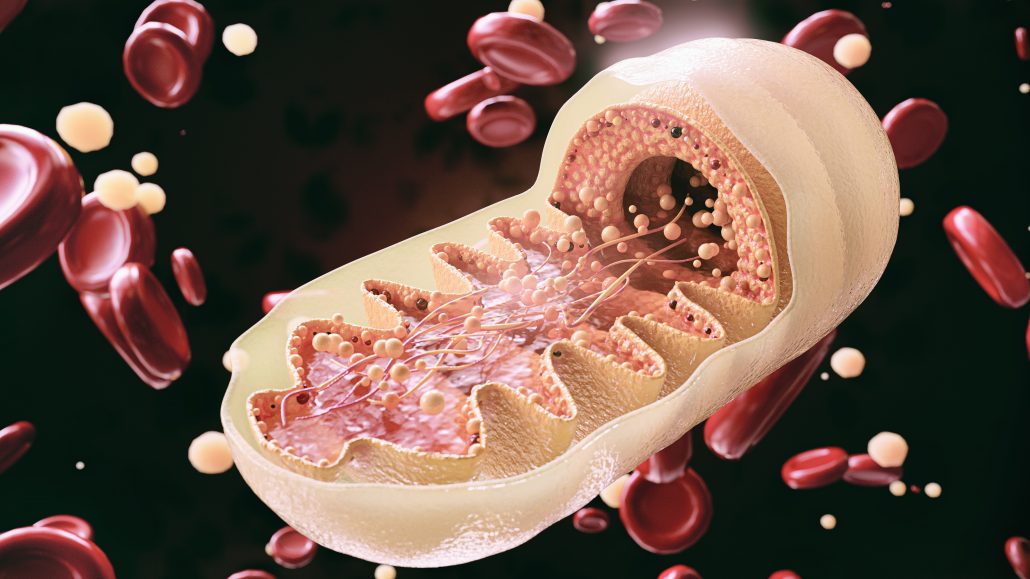Strengthening Your Mitochondria to Support Healthy Energy Production
Introduction

Fatigue is one of the most common symptoms seen in primary care.1 Symptoms of fatigue can be acute during illness, or chronic, lasting months to years. The important thing with fatigue is to uncover the biological cause.
One of the primary causes of fatigue is mitochondrial dysfunction. The mitochondria provide our cellular energy, and when they are not functioning optimally, our cells’ energy production is low, leading to the symptoms of fatigue.
What are mitochondria and why are they important?
Mitochondria are small organelles that exist inside cells for the primary purpose of creating energy in the form of ATP. All of our food is composed of the macronutrient’s carbohydrates, proteins, and lipids. These macronutrients are broken down into acetyl-CoA, which begins the Krebs or Citric Acid Cycle.
This cycle feeds into the mitochondrial membrane, where oxidative phosphorylation takes place. Oxidative phosphorylation and the formation of ATP happens through the electron transport chain. The electron transport chain has complexes I-V, which are critical for forming ATP. This energy production requires multiple cofactors that, if low, could decrease the production of ATP. There are numerous steps in the development of energy, beginning with the breakdown of the macronutrients.
Testing for mitochondria function
One of the common questions from practitioners is how do I test mitochondrial health? Classic mitochondrial testing was done by muscle biopsy, which is invasive. Other methods for testing mitochondrial health exist. Mitoswab is a genetic test done by a cheek swab. It evaluates complexes I-IV of the electron transport chain, which can help identify support such as supplementation of CoQ10.
Both blood markers and organic acid urine test markers can be helpful in assessing mitochondrial health. Blood tests include a complete metabolic panel, pyruvate, lactate, creatinine kinase, CoQ10, free and total carnitine, plus an acylcarnitine profile and amino acids.
Since oxidative stress can have such an effect on mitochondrial function, measuring markers of oxidative stress can be useful additional information. Although there are many research markers of oxidative stress, available markers that can be helpful are F2-isoprostanes, markers of lipid peroxidation, and 8-hydroxy-2-deoxyguanosine (8-OHdG), a marker of mitochondrial DNA damage.
How can you support healthy mitochondria function?
Supporting healthy mitochondrial function involves supporting multiple different factors.
The mitochondrial membrane is made from phospholipids, including phosphatidylcholine (PC), phosphatidylethanolamine (PE), phosphatidylinositol (PI), phosphatidylserine (PS), and phosphatidic acid (PA), as well as phosphatidylglycerol (PG) and cardiolipin (CL).6 Both phosphatidylglycerol and cardiolipin are unique to mitochondrial membranes.6 Supplementing phospholipids may help support a healthy mitochondrial membrane and is an important component of supporting healthy mitochondrial function.*
The production of energy by the mitochondria is a multi-step process involving cofactors, including many vitamins and minerals. These nutrients, including NADH, CoQ10, and carnitine, can be low from poor dietary intake amd aging. Pyrroloquinoline quinone (PQQ) has been found to be important in energy production by the mitochondria and acts through cell signaling pathways.8 PQQ supplementation has been shown to support mitochondrial health.8 NAD/NADH and many of the B vitamins are also important cofactors in mitochondrial energy production.9 Supplementing with a combination of B vitamins, NAD/NADH, CoQ10, PQQ, and carnitine along with the phospholipids is a good foundation for supporting mitochondrial health.*
Finally, we know that antioxidants neutralize free radicals. Vitamin C, vitamin E, and alpha-lipoic acid may provide antioxidant support and promote mitochondrial health.10
When used together, alpha-lipoic acid (ALA) and vitamin E in animal studies showed support of the mitochondrial electron transport chain.11 Adding antioxidants may help support mitochondrial function when combined with targeted mitochondrial nutrients and phospholipids.
Summary
Mitochondrial health is important in cellular energy production as well as many other functions. Testing options exist for assessing mitochondrial health and function, and mitochondrial health may be supported through a multi-faceted approach involving a range of nutrients to support the phospholipid membrane, supply targeted cofactors, and provide antioxidants to reduce free radicals.
References
- Wright J, O’Connor KM. Fatigue. Med Clin North Am. 2014 May;98(3):597-608..
- Filler K. Et al. Association of mitochondrial dysfunction and fatigue: a review of the literature. BBA Clin. 2014;1:12–23.
- Wood E, Hall KH, Tate W. Role of mitochondria, oxidative stress and the response to antioxidants in myalgic encephalomyelitis/chronic fatigue syndrome: A possible approach to SARS-CoV-2 ‘long-haulers’?. Chronic Dis Transl Med. 2021;7(1):14-26.
- Morris G., Maes M. Mitochondrial dysfunctions in myalgic encephalomyelitis/chronic fatigue syndrome explained by activated immuno-inflammatory, oxidative and nitrosative stress pathways. Metab Brain Dis. 2014;29:19–36.
- Starkov A.A. The role of mitochondria in reactive oxygen species metabolism and signaling. Ann NY Acad Sci. 2008;1147:37–52.
- Zinser E. et al. Phospholipid synthesis and lipid composition of subcellular membranes in the unicellular eukaryote Saccharomyces cerevisiae .J. Bacteriol. 1991. 173:2026–2034.
- Ma ZA. The role of peroxidation of mitochondrial membrane phospholipids in pancreatic β -cell failure. Curr Diabetes Rev. 2012;8(1):69-75.
- Harris CB. Et al. Dietary pyrroloquinoline quinone (PQQ) alters indicators of inflammation and mitochondrial-related metabolism in human subjects. J Nutr Biochem. 2013 Dec;24(12):2076-84.
- Ying W. NAD+/NADH and NADP+/NADPH in cellular functions and cell death: regulation and biological consequences. Antioxid Redox Signal. 2008 Feb;10(2):179-206.
- Sagan KC , Cárcamo JM, Golde DW. Vitamin C enters mitochondria via facilitative glucose transporter 1 (Glut1) and confers mitochondrial protection against oxidative injury. FASEB J. 2005 Oct;19(12):1657-67.
- Eser Faki H, Tras B, Uney K. Alpha lipoic acid and vitamin E improve atorvastatin-induced mitochondrial dysfunctions in rats. Mitochondrion. 2020 May;52:83-88.
